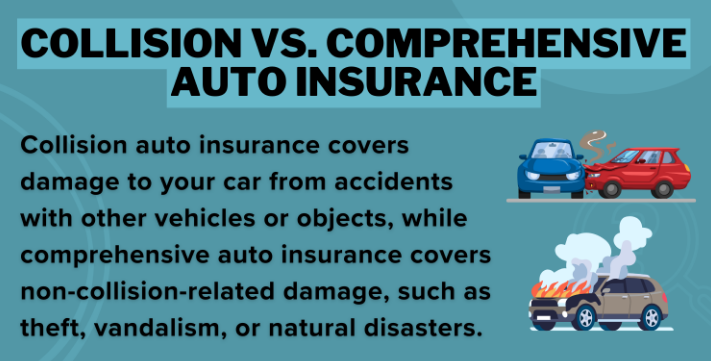When it comes to car insurance, two of the most common and important types of coverage are comprehensive and collision. Both offer protection in the event of an accident, but they cover different situations. Understanding the difference between these two types of coverage is essential to choosing the right insurance policy for your needs. This article will break down the key differences between comprehensive and collision coverage, explaining what each covers, when they apply, and how they can affect your premiums.
What is Comprehensive Coverage?
Comprehensive coverage, often referred to as “other than collision” coverage, protects your car against damage that is not caused by a collision with another vehicle or object. Essentially, this type of coverage safeguards your vehicle from risks that are outside your control and occur while your car is parked or in motion. Comprehensive coverage is often bundled with collision coverage in a full coverage insurance policy.
What Does Comprehensive Coverage Include?
Comprehensive coverage protects you against the following scenarios:
- Theft: If your car is stolen, comprehensive coverage will help pay for the loss of your vehicle, subject to your policy’s limits and deductible.
- Vandalism: If someone intentionally damages your car, such as keying it or breaking windows, comprehensive coverage can cover the repairs.
- Natural Disasters: Damage from weather-related events like hailstorms, hurricanes, floods, tornadoes, or wildfires is covered by comprehensive coverage.
- Animal Collisions: If you hit a deer or another animal, comprehensive coverage will help pay for the repairs to your car.
- Falling Objects: Comprehensive coverage will pay for damage caused by falling objects, such as tree branches or debris from a storm.
- Fire: Damage to your vehicle caused by fire, whether from an accident or a random event, is typically covered under comprehensive coverage.
- Glass Damage: Damage to your windshield or windows from a variety of causes (e.g., rocks or debris on the road) can be covered under comprehensive coverage.
When Does Comprehensive Coverage Apply?
Comprehensive coverage applies when your vehicle is damaged by any event that isn’t a collision. This means that if your car is damaged in a way that wasn’t caused by hitting something or another vehicle hitting you, comprehensive coverage would kick in. For example, if a tree falls on your car during a storm, your comprehensive coverage will help pay for the damage, minus the deductible.
Is Comprehensive Coverage Required?
Comprehensive coverage is optional unless you have a car loan or lease. In this case, your lender or leasing company may require you to have comprehensive coverage to protect the value of the car. If you own your car outright, you are not required to carry comprehensive coverage, but it’s often recommended for those with newer or high-value vehicles.
What is Collision Coverage?
Collision coverage, on the other hand, covers damage to your car when you collide with another vehicle or an object, regardless of who is at fault. This type of coverage is designed to protect you in accidents involving another vehicle, a stationary object, or any accident where your car’s structure is compromised due to the impact.
What Does Collision Coverage Include?
Collision coverage helps pay for the repair or replacement of your car if it’s damaged in a collision. The coverage typically applies in the following situations:
- Accidents with Another Vehicle: If you crash into another car, whether you’re at fault or not, collision coverage can help cover the damage to your vehicle.
- Collisions with Objects: If you hit a fence, guardrail, tree, or any other object while driving, collision coverage will pay for repairs to your car.
- Rollovers: If your vehicle rolls over during an accident, collision coverage can help pay for the cost of repairs or replacement.
When Does Collision Coverage Apply?
Collision coverage applies whenever your car is involved in a crash, regardless of whether you’re at fault. For example, if you rear-end another car, collide with a wall, or even hit a pothole that causes damage to your car, collision coverage will pay for the repairs or replacement. However, collision coverage does not pay for injuries to you or other passengers; that would fall under personal injury protection (PIP) or health insurance.
Is Collision Coverage Required?
Collision coverage is not legally required by state law, but if you have a car loan or lease, your lender or leasing company will likely require you to carry it. If you own your vehicle outright, you are not obligated to have collision coverage, but it is strongly recommended if you want protection for your car in case of an accident.
Key Differences Between Comprehensive and Collision Coverage
While both comprehensive and collision coverage are part of a well-rounded auto insurance policy, there are key differences in what they cover, when they apply, and how they work together to protect your vehicle. Here’s a comparison of the two:
| Coverage Type | Comprehensive Coverage | Collision Coverage |
|---|---|---|
| What It Covers | Non-collision damage (e.g., theft, vandalism, fire, natural disasters, hitting animals) | Damage from accidents involving other vehicles or objects (e.g., crashes, rollovers) |
| When It Applies | When damage is caused by external events (weather, theft, vandalism, etc.) | When your car collides with another vehicle or object, regardless of fault |
| Required by Law? | No, unless required by a lender or lease agreement | No, unless required by a lender or lease agreement |
| Typical Deductible | Deductibles vary, typically range from $100 to $500 | Deductibles vary, typically range from $250 to $1,000 or more |
| Coverage Limit | The actual cash value of your car (minus your deductible) | The actual cash value of your car (minus your deductible) |
| Example | Damage caused by a falling tree, vandalism, theft, or hitting an animal | Accident with another car, collision with a tree, or crashing into a fence |
Which Coverage Should You Choose?
The decision to add comprehensive and collision coverage to your policy depends on your situation, the value of your car, and your budget. Here are a few factors to consider:
Comprehensive Coverage:
- Recommended for Newer or High-Value Vehicles: If your car is relatively new or has a high market value, comprehensive coverage is highly recommended. It can protect your car against theft, vandalism, and other events that could lead to significant financial loss.
- Living in High-Risk Areas: If you live in an area prone to natural disasters (e.g., hurricanes, hailstorms, wildfires) or have a high rate of car theft, comprehensive coverage can be a wise investment.
- Lender or Lease Requirements: If you have a car loan or lease, your lender or leasing company may require comprehensive coverage to protect their investment in the vehicle.
Collision Coverage:
- Recommended for Vehicles with Higher Value: If you’re driving a newer or more expensive car, collision coverage can help ensure you don’t have to pay out-of-pocket for costly repairs or replacement in the event of an accident.
- Frequent Drivers: If you spend a lot of time on the road, collision coverage can offer valuable protection in case of accidents with other vehicles or objects.
- Lender or Lease Requirements: Like comprehensive coverage, collision coverage is often required by lenders or leasing companies.
When You May Opt Out:
If your car is older and has a low market value, the cost of comprehensive and collision coverage may not be worth it. If the car’s value is lower than the cost of coverage, you might choose to forgo these options and save on premiums. Additionally, if you have enough savings to pay for repairs or replacement out-of-pocket, you may feel comfortable removing these coverages.
Conclusion
Comprehensive and collision coverage are both essential components of a full coverage auto insurance policy, but they serve different purposes. Comprehensive coverage protects you against non-collision damage, such as theft, vandalism, and natural disasters, while collision coverage covers accidents involving other vehicles or objects. The right combination of both can give you peace of mind and protect your financial investment in your vehicle. When choosing your coverage, consider the value of your car, your risk factors, and your budget to ensure you have the right protection.







